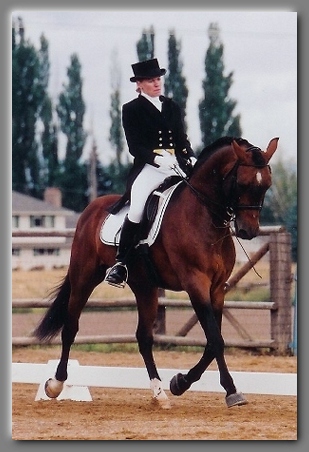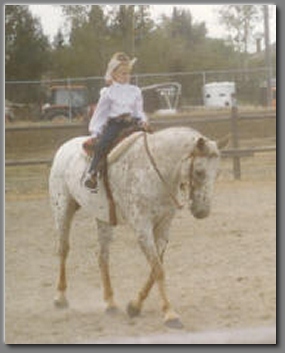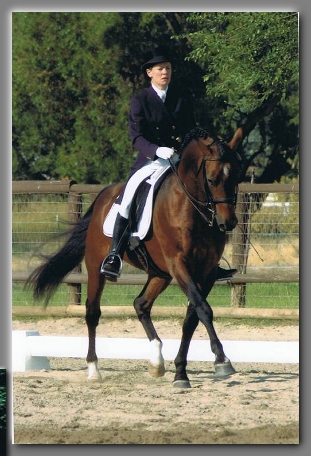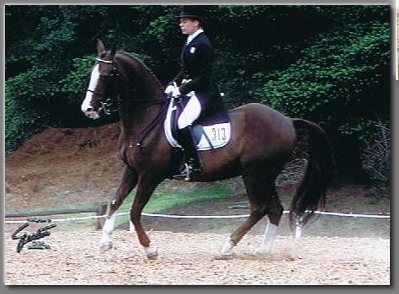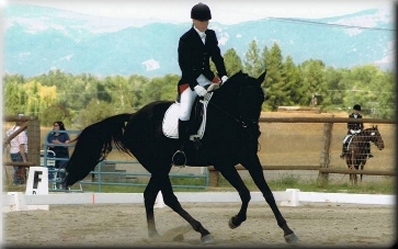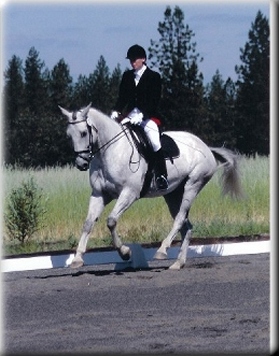Training
My Father started me out in the horse world by purchasing my first show horse Mehrs Eloquince. He was an eleven year old gelding and we paid $3,500 for him at the time. Dad could not believe he paid that much for an old gelding! We went on to compete at Grand Prix and he is now one my lesson horses. I have trained and competed two Morgans through the FEI levels. In 1997 and 1998 my Thoroughbred gelding and I competed on the USDF Region 6 North America Young Rider team. My retired gelding Merhs Eloquince became one of the eight Morgans to receive the AMHA gold medallion. I have received my USDF bronze, silver and gold medals on non-traditional dressage horses. Together, with the help of Jeanne Gaudreau, Debbie Riehl-Rodriquez, Mike Osinski, Steffen Peters and Conrad Schumacher, I trained and competed Iron Forge Starman to Grand Prix. I received my USDF Gold medal scores while riding Starman. We also have won many awards and received numerous compliments throughout our years together. Starman was retired from the dressage arena in 2008 and currently lives the life of luxury with his mares. This wonderful guy has taught me many things over the years and I felt great pride every time I rode him into the dressage arena! I enjoy helping people find a suitable equine partner and I am currently accepting horses for training and giving lessons. Call for pricing. I can be reached at 406-212-1231 or sally@montanasky.us This is an article written about my journey to Grand Prix with my Morgans. It was originally published in the Morgan Dressage Association’s newsletter.
Tears, Sweat and Stubbornness
By Sally Anderson
That winter I made the commitment to start taking lessons on a weekly basis and clinic monthly. I could see how dressage helped with the training of a horse and fit well with our Morgans and over the next few years we moved up a level a year. Quincy and dressage helped me through my trying times of adolescence and high school. They both taught me how to stay focused and kept me away from boys much to my parents delight.
My Mother was a great supporter and enjoyed the horse activities just as much as I did. Together we decided that it was time to start training our young stallion, Iron Forge Starman. He was a 5 year old and had only been turned out with mares on 640 acres. We hooked up the trailer and headed up to the mountains to round him up. Starman turned out to be very trainable and had a lot of talent for dressage. He became a star right along side of Quincy. People commented that he looked like a small warmblood.
In 1997 and 1998 at the age of 20, I loaded both of these boys up along with a Thoroughbred gelding and headed to Washington State for the show season to try and earn a spot on the Junior Young Rider team. With the help of Mike Osinski, we made great progress and I fulfilled my goal of competing on the Team two years in a row. It was an unforgettable experience to compete on our region’s team at an international level and to enjoy excellent instruction. Because the Young Rider tests were equivalent to fourth level and Prix St Georges I was able to earn my USDF silver medal and in 1999 my bronze medal on Starman, My horses and I made great progress during this time because of the intense training. I am indebted to this experience because I learned how to execute a precise test.
I married shortly after and moved my horses off the ranch permanently. The horses were introduced to a boarding facility and I to city life. This was the time in my life where I became acutely aware of how much I depended on my Morgans and my riding. I struggled making progress with my horses because I was only able to clinic four times a year with Debbie Rheil-Rodriquez. I had to haul four hours each way over mountain passes in the winter but it was worth the effort and my new husband even helped with the driving.
In 2001 Quincy and I showed at Grand Prix. Quincy always had a special mind and was able to master the tricks of the test but not necessarily the collection aspect. He could do one tempis all day but passage was not his cup of tea. Quincy was 22 at the time and I was pregnant with our first child, it was very trying, emotionally and physically but we made it! We were only able to compete one year at Grand Prix because of Quincy’s age and the new baby. Quincy retired from the dressage arena but went on to teach the girl that went with us into those Grand Prix test how to ride. He was a special horse in every aspect of his life. Not only did he teach me in the in’s and out’s of riding but also blessed my daughter with her first ride. He never broke a 60% at Grand Prix but he physically shouldn’t have made it there either. He was a swayed back old guy with straight hind legs and it was only his mind that took him to the top. Quincy was the corner stone through my younger years and taught me a lot, not only about riding but about how trying is more important that having the natural talent. I hope my daughter will have another horse as special as him.
While Quincy was enjoying the easy life of kiddy rides Starman was still working his way up the levels. In 2003 and 2004 we were able to show at Intermediare 1 and then we had to take a break becasue I was once again pregnant! By this time in our life we had moved back to Montana and I was able to clinic with Debbie Rheil-Rodriquez on a regular basis. My parents had also retired off the ranch and moved closer to us. I was able to ride regularly as I had a full time baby sitter (Mom!)
Where Quincy shined at the tricks Starman struggled. He had a beautiful passage and loved to show it off but the one tempis were mentally hard for him to grasp. By 2007 we were ready to hit the show ring once again and tackle the Grand Prix test. By the middle of the season we had earned one 60 and were half way to getting that elusive Gold medal and by the end of the show season we were still only half way there! All winter long we polished that test up and tried to master those transitions in and out of piaffe, one tempis and canter pirouttes so we could get that last elusive score!
In the spring of 2008 we were back in the arena trying hard and in early summer we were still trying hard for that score. I even took four lessons in a row with Jeannie Gaudreau working on every part of the Grand Prix test before a show. I received the lowest score of my life at the show. It was a very hard set back and I had to really evaluate my riding skills and if we were truly ready for this level. I took the time to lesson often and ask the hard questions. I decided I wasn’t going to give up on this talented horse and we went back to that arena and rode with every thing we had at the last show that year. The first test we scored a 60% and my husband was right there to take our picture holding the test! I felt a ton of bricks lift off my shoulders and the next day I was all smiles and so proud of Starman I let him take over for that last ride in dressage ring together. The final score was a 62%, what a great way to end a career. He came off the trailer after the show and went directly out with his favorite mare!
Starman has always given every thing he has to each ride and was an amazing partner. The best part of this is I get to see it in each of his offspring that I train. I have been blessed with two wonderful Morgan horses that have taught me not only a lot about riding but about life and what it takes to pursue your dreams and have the every day stubbornness to stick with it. As my knowledge about riding keeps increasing I wish I could go back and change some of the things these poor boys had to deal with, but that only speaks louder for the types of horses they were and are. My next goal, to pass on what I have learned from theses horses about riding, life and love to the people I teach, am around and also to make the journey easier for that next special Morgan to Grand Prix.
Another Morgan Dressage Association Article about the history on both Moana Morgans and EMR Morgans
The Story Behind EMR Morgans
A family affair that is rich in the history of ranching and Morgans in Montana tells its stories
By Ed Radtke
Both of Ed’s grandfathers were horsemen. Grandpa Atwell was a noted teamster in Granite county where he ranched. Atwell’s team was noted for their ability to pull heavy loads when other teams had given up. Ed’s paternal grandfather, F.E. Radtke, raised registered Per- cherons in North Dakota. Grandfa- ther Radtke had two stallions he took state-wide breeding mares every spring. He crossed these stallions on Morgan mares and raised many fine horses. These horses were used for farming, under saddle and light driving.
In 1936 Ed’s father Marvin Radtke moved to Montana to find work during the depression. Marvin started working on local ranches in the summer and in mines in the winter. During this time he married the Al- berta Atwell, a daughter of local rancher. Shortly after, they pur- chased a ranch from the infamous feuding Dooley clan, but that’s an- other story. This same year they had their second child, Ed. Ed always said it was the very best year they had.
A neighboring rancher of Marvin’s was Hans Koefoed. Hans had emi- grated from Denmark when he was nineteen and liked quality horses for both draft and saddle. Hans rode a part Morgan that weighed around thirteen hundred pounds called Brownie. This horse wore a size three shoe and Hans liked to say he never tied a rope on anything Brownie could not pull. Hans owned a very large ranch and needed quali- ty cow horses. He wanted a horse that would go from early morning until dark and at times longer. These horses needed to be fifteen hands or more with short backs, a good mind and good cow sense. To fill these requirements, Hans purchased a Morgan colt from Bill Jackson who was a noted Montana Morgan breed- er. This colt was a solid bay named Luzan. Luzan was by Juzan by Jubilee King and out a mare that went back to Revere and Chief Bugler. Bill Jackson had purchased Juzan from the JC Brunk ranch.
Luzan was an excellent ranch horse who could with stand the mountainous terrain, and move and sort cattle with ease. His easy temperament allowed him to be transported in a stock truck along side mares and geldings. Luzan was so quick cutting cattle he threw a local cowboy off with one of his turns.
Hans never raised any registered Morgans and his sole desire was to have good stock horses. Luzan fulfilled this purpose by producing wonderful stock horses from a wide variety of mares. Ed worked for Hans starting many of these horses for him; his favorite being the Morgan crosses to work with that were out of three albino mares. The crosses were a brilliant copper color, excellent in the mountains and had abundant cow sense.
Luzan was purchased by Marvin at Hans’ estate sale. During this time period Marvin purchased a mare, Leota, by Red Racer from Ann Hays. Ed purchased her filly, Kootenie Madie’s Girl who was by Madie Canfield by Mansfield. This was the foundation of Moana and EMR breeding programs and the start of a life long dream for both Marvin and Ed.
Madie’s Girl was a very good mountain horse, tough as nails and one you could ride from early morning until dark. Ed says the only way he got Valerie to marry him was by telling her he would give her this mare. Forty one years later he still thinks he got the best of the deal, however don’t ask what Valerie thinks. Madie’s Girl’s progeny are still in the EMR breeding program.
After Luzan, Marvin purchased Joe Daly, by Domino Joe. This stallion crossed on Luzan’s offspring added more size to the horses while still retaining the easy training ability. Joe Daly introduced Flyhawk bloodline into their Jubilee King breeding program. This is called the golden cross of Morgan world.
In 1989, Ed and Valerie purchased Iron Forge Starman, from Pruett and Sherrie Helm. Starman, is by Something Blue by HVK Santana and out of Cambridge Suzy Q who had 17 crosses to Jubilee King. This revived the Jubilee King blood in the EMR breeding program. While Starman was not purchased for a sport horse, Sally Radtke-Anderson trained and competed him successfully to Grand Prix. He has taken Ed and Valerie’s horses to a new level of trainability and has proven to be a wonderful asset.
For over 50 years, Ed has moved cattle many miles and rode for long hours and still does. He has ridden alongside Thoroughbreds, Quarter Horses, Arabians and crosses of all kind and has never been left behind, followed anyone or felt out horsed on his Morgans. In Ed’s humble opinion, or maybe not so humble, Morgans can do it all with the best of them. Ed says he has now become a professional stall cleaner.
EMR Morgans’ junior stallion, Flower of Alliance will be adding Flyhawk once again into the breeding program. He is Caduceus bred and a great grandson of Wyoming Flyhawk.
After leasing their cattle ranch at Hall to their two sons, Valerie and Ed have moved to Bigfork, Montana. They, along with their daughter Sally, now focus entirely on raising Morgans and have found the horses they bred for ranch work are well suited for the sporthorse world. EMR Morgans have been sold for trail, working cattle, jumping, dressage, driving and just equine partners. www.EMRMorgans.com
